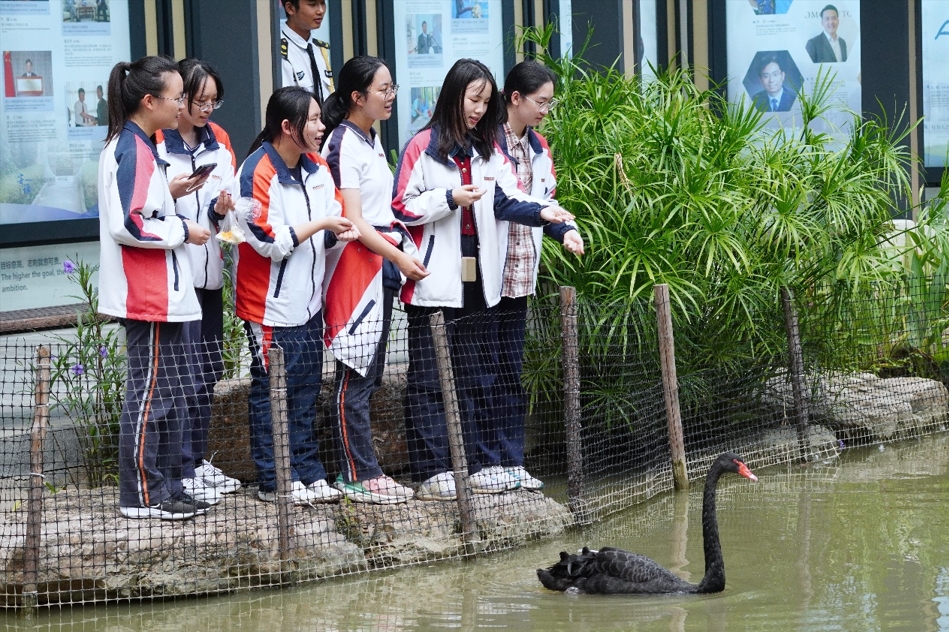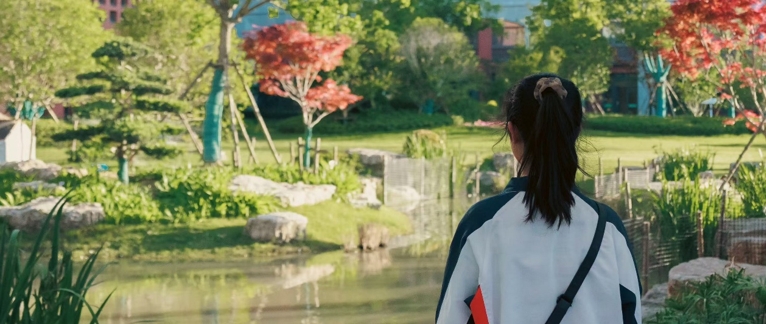
Editor’s note: The 2024 Smart Talks on Climate Change program, jointly organized by Yale Center Beijing and Yale Center for Carbon Capture, culminated in an essay competition where participants submitted essays on "What is a natural climate solution that you've noticed in your own personal context? How might inplementation of this solution at the local level have an impact on the global level?" This is a piece written by one of the winners of the 2024 essay competition.
Our school bought two Swarovski with over 600 dollars.
Immediately, the two black swans became the talk of the town. Groups of students gather around the campus pond daily to watch them glide leisurely across the water, occasionally pecking their feathers or flapping their wings. The swans are rare residents of schoolyards, especially when urban ponds are scarce on school campuses in modern cities. Many school campuses neglect pond ecosystems, despite their ability to enhance biodiversity and provide ecological services, which are often underutilized in educational environments (Hassall, 2014). Thankfully, with our school’s advanced effort, we get the chance to live with these beautiful creatures. Combining Green Infrastructure and Blue Infrastructure, our pond has demonstrated advanced attempts of Nature-based Solutions, which I highly recommend for more schools.

The microhabitats perform an important role in promoting urban biodiversity. In our school, the greenery around the pond provides a popular resting spot for sparrows and white-headed Bulbuls. Koi fish and schools of small fry swim around, drawing soft ripples. I conducted months of investigation and observed the number of nearby species increasing, with over five types of dragonflies, two types of damselflies, and several types of butterflies being regularly sighted. Excitingly, a Chinese pond heron got attracted here and settled cozily. Together, they contribute to this balanced and vibrant ecosystem, as research has pointed out, urban ponds serve as habitats that enhance local biodiversity, facilitating ecological balance despite urban pressures (Hassall, 2014). As biodiversity plays a crucial role in promoting ecosystem resilience and carbon sequestration, it greatly empowers climate mitigation and adaptation.

Beneath the shimmering water lies the pond’s great potential as a climate buffer. Studies show that wetland ecosystems like ponds are effective in sequestering carbon, thus helping mitigate climate change by storing CO2 in sediments and plant life (Rogerson et al., 2021). The photosynthesis of aquatic plants, microorganism activities, and organic sediment accumulation all contribute to the process. Besides, urban ponds help with climate regulation by cooling surrounding air and mitigating urban heat island effects through evaporative cooling and water management (Oertli & Parris, 2019). The pond, with the plantation around, constitutes a green space with fresh air and moderate temperature. In rainy seasons, the small pond is like a natural retention basin, collecting rainwater and preventing runoff that could cause erosion or flooding on campus. By fostering such microclimates, our pond helps with climate adaptation, improving the campus’ resilience to extreme weather and temperature fluctuations.
What I appreciated the most is the pond’s significant spiritual role: beyond adapting to climate change, the pond helps students mediate their mental climate. In times of stress, many find solace by sitting beside the water, watching the black swans glide across the surface. Research shows green and blue spaces, including urban ponds, are linked to improvements in mental health, which enhances overall well-being (Marselle et al., 2021). With ponds in schools, the spiritual climate of the campus is tied to the natural one. This connection to nature not only benefits students’ well-being but also fosters a deeper appreciation for the environment and a commitment to protection within the young generation.

I understand that many barriers impede the construction of urban ponds on school campuses: limited space, population pressure, complex approval procedures, and required expense (which are common in Chinese schools). Consequently, promoting the pond ecosystem on school campuses calls for the integrated effort of the school, the government, and the public. Schools as the start-ups for promoting Blue Infrastructure, the significance of urban ponds also requires recognition in policy-making and urban planning. This way, urban microhabitats might give full play to their potential as an important natural climate solution, laying the foundation for the global application of pond microhabitats in climate adaptation.
To me, the pond’s greatest potential lies in its amazing effect that 1+1>2: the integration of multiple microhabitats is not simply adding up the total carbon reduced. Connecting diverse microhabitats creates corridors for species to move around, which benefits the urban ecosystem, and lights up the grey urban life (imagine a lovely squirrel popping its little head out from among the lush green trees)! Starting from schools to a grander public, from dots of green to bigger patches of verdancy, our city shall be adorned with vibrant nature, igniting its vitality in the face of climate change.
The renowned ancient Chinese philosopher Laozi once said, "The highest goodness is like water." A simple pool of water has the amazing power to bring the spring of nature. The urban pond isn’t just a scenic spot, it reminds us to reflect on the human-nature relationship and go beyond anthropocentrism, restoring the harmonious coexistence of humans and nature— it’s the vital ally in the journey toward a more sustainable and climate-conscious world. Let urban ponds thrive in schools like in the spring!
Reference
Hassall, C. (2014). The ecology and biodiversity of urban ponds. Wiley Interdisciplinary Reviews: Water, 1. https://doi.org/10.1002/wat2.1014.
Marselle, M., Lindley, S., Cook, P., & Bonn, A. (2021). Biodiversity and Health in the Urban Environment. Current Environmental Health Reports, 8, 146 - 156. https://doi.org/10.1007/s40572-021-00313-9.
Oertli, B., & Parris, K. (2019). Review: Toward management of urban ponds for freshwater biodiversity. Ecosphere. https://doi.org/10.1002/ecs2.2810.
Rogerson, R., Horgan, D., & Roberts, J. (2021). Integrating Artificial Urban Wetlands Into Communities: A Pathway to Carbon Zero?. , 7. https://doi.org/10.3389/fbuil.2021.777383.
At the time of submission, Yichen Li was a 11th grader at Nanjing Foreign Language School.